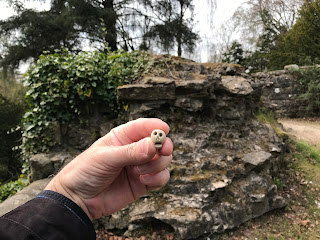If you have ever travelled on the East Coast Railway line from Edinburgh down towards London, you will have passed through Berwick upon Tweed. After pulling out from the station you may have noticed the pier and the rather iconic lighthouse out on your left side as the train begins to build up speed and shoot off down the line. If you have the time, take a trip to Berwick upon Tweed one day and have a good walk around. There is plenty to see in Berwick itself and across the bridge in Spittal there is a lovely, big sandy beach and also a bit further along, a clifftop path, which I think eventually takes you to Holy Island. Or you could just take a rather bracing walk out on the pier to Berwick Lighthouse where the North Sea winds will batter you, no matter how calm the day is in the town.
Berwick
Lighthouse was built in 1826 to a design by Joseph Nelson. He was also responsible for the building of
the lighthouses at Lundy and Longstone.
The lighthouse took eight months to build and was opened with much pomp
and ceremony. The light was turned on
for the first time on 10 October 1826.
In
1927 the lighthouse made the news because it was being run by a woman (Yup,
that was big news back then!). The
lighthouse keeper at that time had taken ill and his daughter stood in for her
father for a few weeks carrying out his duties at the lighthouse. Something she said she enjoyed though did find
a little lonely, as there was not even a wireless there to keep her company.
The
keepers often worked in the lighthouse during extreme weather. In 1937 William
Cowe described his experiences to a reporter from the Berwick Advertiser of
working there while a severe storm raged outside. He described how huge waves had pounded into
the building making it sway, while other waves had been so big that they had
crashed right over the top of the lighthouse.
The seas had been so rough that at times the pier had been under at
least four feet of water. However, Cowe
had felt quite safe within the lighthouse and the light had not failed once
during the storm.
In
1947 the lighthouse was automated, and the keepers were no longer required.
The
lighthouse has featured in works by artists such as L S Lowry and Emrys
Williams. Given its iconic looks and the
ever-changing seascape and skyscape around it, it will no doubt continue to
inspire artists for years to come.
Today,
on yet another grey and cold day, I took a walk to Spittal Beach and then back
and around Berwick before heading over to the pier and along to the
lighthouse. I battled through the
howling wind and past group after group of cold tourists, who like me, were
just desperate to be out and about. On
reaching the lighthouse I left the Skulferatu that had accompanied me on my
walk around Berwick by one of the metal structures on the pier wall.
The
coordinates for the location of the Skulferatu are –
Latitude 55.764873
Longitude
-1.984140
I used the following sources for information on the lighthouse –
The Berwick Advertiser –
Thursday 3 March 1927
Berwickshire News and General
Advertiser – Tuesday 1 May 1928
The Berwick Advertiser –
Thursday 4 February 1937
Berwickshire News and General
Advertiser – Tuesday 4 February 1947
Historic England website -
Historic
England - The Pier and Lighthouse, Berwick-upon-Tweed
British Listed
Buildings website -
Pier
and Lighthouse, Berwick-upon-Tweed, Northumberland
Article and photographs are copyright of © Kevin Nosferatu, unless otherwise specified.



















































